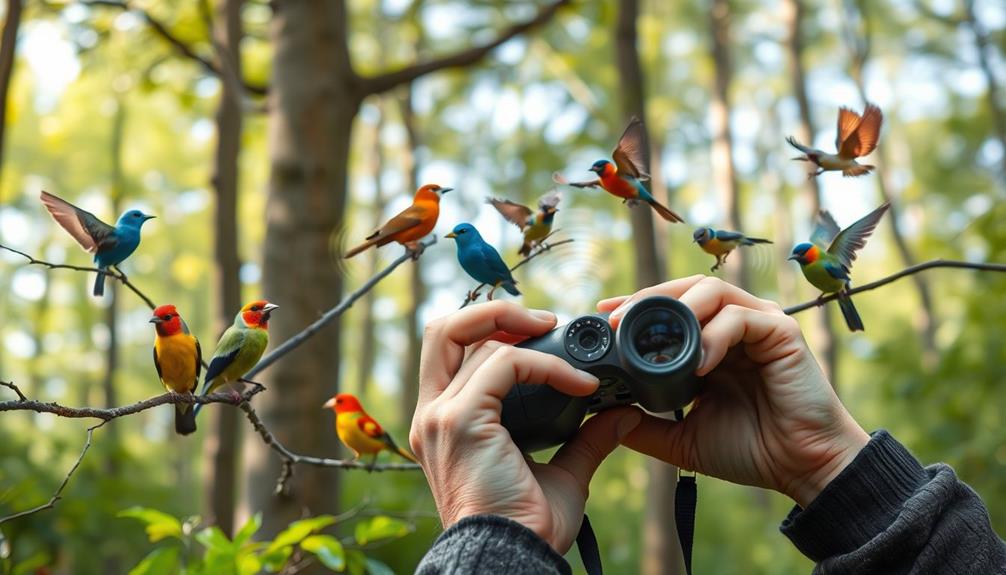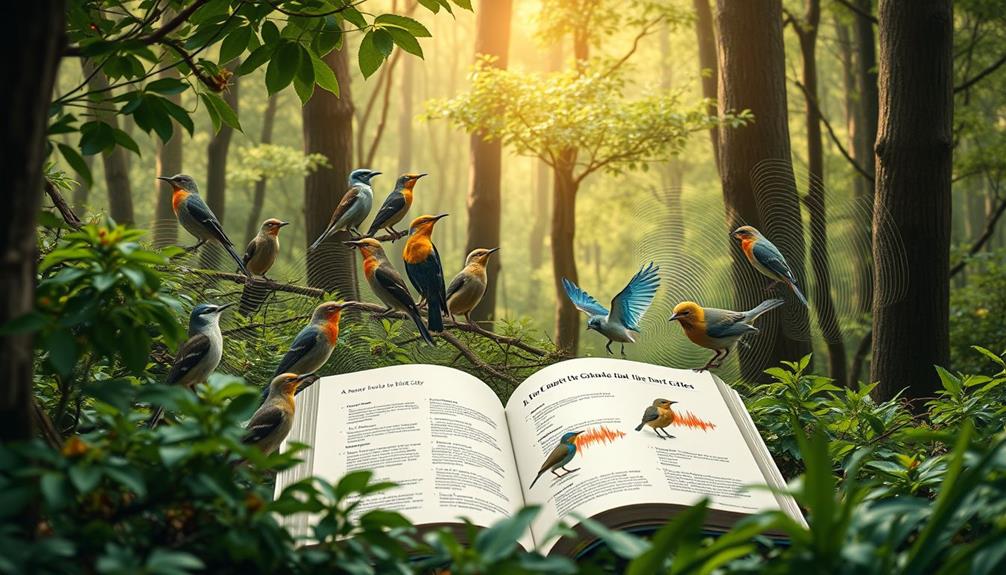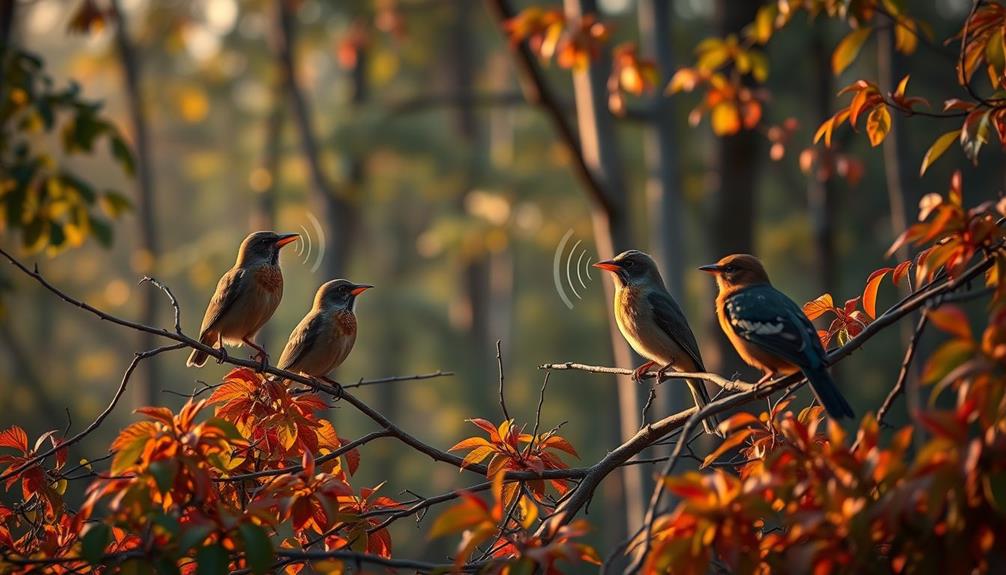Identifying bird calls is a rewarding skill that enhances your birdwatching experience. Start by focusing on one call at a time to improve retention. Listening to recordings and using mnemonics can help you remember sounds better. Pay attention to the characteristics of different species—smaller birds often have higher-pitched songs, while larger ones produce deeper tones. Remember, the best time to hear diverse calls is during spring's dawn chorus. With resources like the Merlin Bird ID app or Audubon guide, you'll sharpen your skills. Stick around, and you'll discover more tips to elevate your birding journey!
Key Takeaways
- Start by focusing on one bird call at a time to improve retention and recognition skills.
- Use mnemonic devices to associate unique sounds with memorable phrases for better recall.
- Regularly listen to recordings of bird calls, reinforcing audio memory through repetition.
- Observe birds visually while they sing to connect visual identification with their vocalizations.
- Utilize apps like Merlin Bird ID and Audubon Bird Guide to enhance your sound recognition abilities.
Importance of Birding by Ear
Birding by ear is essential for any birdwatcher looking to enhance their experience. By honing your auditory skills, you can detect birds even in dense environments where visual identification proves challenging. Vocalizations, including songs and calls, provide key insights for distinguishing between similar-looking species, making bird identification easier and more enjoyable. Engaging with new experiences, such as listening to various bird calls, can also promote cognitive flexibility and enhance your overall birding skills, as noted in the benefits of curiosity.
As you practice listening to different bird sounds, you'll notice how these vocalizations reveal species recognition clues that visuals alone can't offer. This skill not only boosts your ability to identify birds but also deepens your appreciation of avian behavior and ecology. The more you immerse yourself in listening practice, the more nuances in their sounds you'll pick up — from the cheerful chirps of sparrows to the haunting calls of owls.
Incorporating birding by ear into your routine can greatly enrich your birdwatching experience. Instead of solely relying on sight, tune in to the symphony of nature around you. You'll soon find that recognizing birds by their songs and calls transforms your outings into a more engaging and fulfilling journey through the world of birds.
Techniques for Learning Calls

To truly master bird calls, you need effective techniques that make learning both efficient and enjoyable. Start by focusing on one bird call at a time. This helps improve your retention and reduces confusion. Pay attention to distinctive qualities like rhythm and pitch, which are vital for identifying birds.
Engaging in outdoor environments while practicing can enhance your learning experience, as exposure to natural environments through outdoor play can boost cognitive retention and recognition skills.
You can also use mnemonics to associate specific sounds with memorable phrases or words. This makes it easier to learn and recall various calls. Regular practice is important; listen to familiar recordings of local bird calls to enhance your recognition and auditory skills.
Additionally, engage in visual observation of birds while they call. This reinforces your audio memory and connects sounds with their corresponding species.
Here are some helpful techniques to boost your learning:
- Use bird identification apps to access a variety of calls.
- Create a bird call playlist for daily practice.
- Join local birdwatching groups for shared learning experiences.
Understanding Bird Song Characteristics

Frequently, understanding bird song characteristics can deepen your appreciation for avian behavior and enhance your identification skills. Bird songs are typically complex and melodic, primarily produced by males to establish territory and attract mates.
As you learn to identify different species, pay attention to the pitch, as smaller birds often have higher-pitched songs, while larger species produce deeper, more resonant tones. Curiously, just as astrology shapes personal confidence, understanding bird songs can boost your confidence in identifying and appreciating these creatures in your environment.
Repetition is another critical characteristic. For instance, the Northern Mockingbird frequently repeats phrases, creating an intricate soundscape, whereas the Brown Thrasher is less repetitive. Observing these patterns can greatly aid your learning process.
Additionally, the tone of bird songs varies widely. Some songs are sweet and melodic, like that of the Blackbird, while others can be harsh and grating, such as the calls of crows. By focusing on these tonal differences, you can distinguish between species effectively.
Seasonal Considerations for Birding

As you become more attuned to bird songs, you'll notice how seasonal changes greatly influence vocal activity.
Spring marks the peak season for bird songs in North America, with a remarkable increase as birds establish territories and attract mates. The dawn chorus, which occurs about an hour before sunrise from March to July, is particularly vibrant, featuring common species like blackbirds and wrens.
During this time, many birdwatchers also enjoy the serenity of tent camping in New England, where they can immerse themselves in nature and observe birds in their habitats.
As you develop your birding skills, keep these seasonal patterns in mind:
- Spring: Expect a cacophony of songs as many species return to breed.
- Summer: Look out for nocturnal singing, especially from robins, adding a unique soundscape to your evenings.
- Autumn and Winter: Prepare for quieter months, as many birds migrate, leading to a significant decrease in vocalizations, with only a few species, like certain woodpeckers, singing sporadically.
Resources for Bird Identification

When you're looking to enhance your bird identification skills, a wealth of resources is available at your fingertips. One of the best tools is the Merlin Bird ID app, which helps you identify over 1,300 bird species using real-time sound recognition.
It also features a Sound ID option that allows you to learn bird songs while they sing. Additionally, you can explore unique dog names to draw inspiration for your furry friends while enjoying nature.
For tracking and reporting sightings, the eBird Platform is invaluable; it connects you with a global community and helps improve your identification skills through shared data.
The Audubon Bird Guide app offers extensive sound libraries and profiles for 821 bird species, making it a fantastic resource for beginners.
If you want to visualize bird songs, Bird Song Hero provides spectrograms to enhance your auditory analysis and sound recognition abilities.
Don't forget about traditional field guides, like the Peterson Field Guide to Bird Sounds, which serve as essential references for understanding various bird vocalizations in different regions.
Frequently Asked Questions
How to Learn to Identify Birds by Sound?
To learn bird sounds, start with common species in your area. Use apps for practice, create mnemonics to remember calls, join local birdwatching groups, and listen to recordings regularly to reinforce your skills.
What Is the Best Free App for Identifying Bird Calls?
To identify bird calls, you should try the Merlin Bird ID app. It's user-friendly, offers sound recognition features, and helps you learn various bird species through engaging real-time identification, all while being completely free.
How to Do a Bird Call for Beginners?
Did you know that over 10,000 bird species exist worldwide? To start bird calling, listen closely to local birds, mimic their sounds, and practice daily. You'll soon develop your unique skills and appreciation for these creatures!
What Is the Easiest Bird Call to Learn?
The easiest bird call to learn is the American Robin's cheerful song. You'll often hear it in gardens during spring. Its melodic tones are distinct, making it a perfect choice for beginners like you.
Conclusion
Whether you're sitting quietly in a lush forest or strolling through a bustling park, the calls of birds can transform your experience. By honing your skills in identifying these sounds, you'll reveal a hidden world of nature's music. From the cheerful chirps of sparrows to the haunting calls of owls, each note tells a story. So, embrace the challenge and let your ears guide you; you might just discover a newfound passion for birding by ear.










